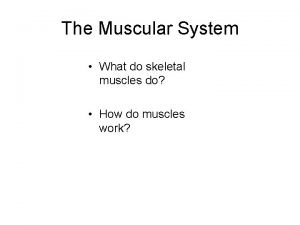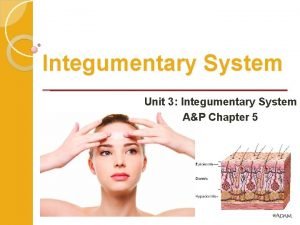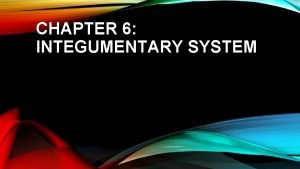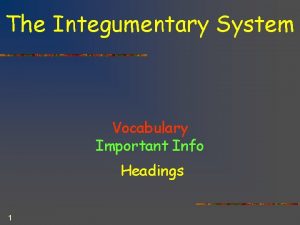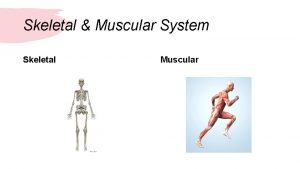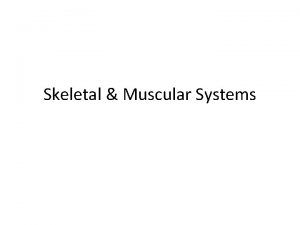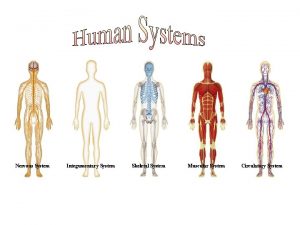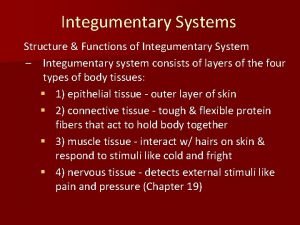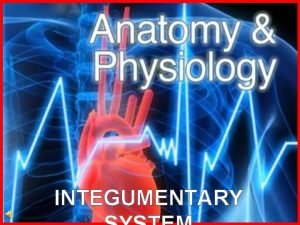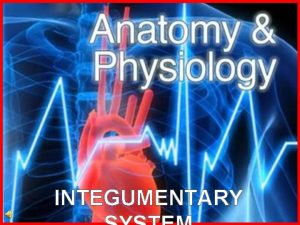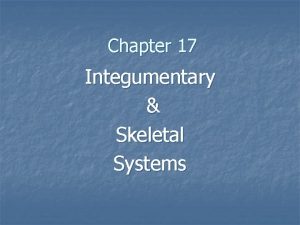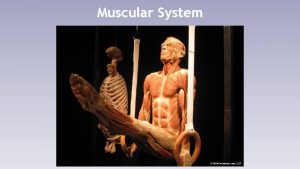Skeletal Muscular and Integumentary System Chapter 32 Skeletal











- Slides: 11

Skeletal, Muscular, and Integumentary System Chapter 32

Skeletal System • Skeleton has two main parts – Axial Skeleton: • The skull, spine, ribs and sternum • The axis of the skeleton – Appendicular Skeleton: • Shoulder and arm bones, hip and leg bones • All the bones of the limbs (appendages) – Scapula, Clavicle, Humerus, Ulna, Radius, Carpals, Phalanges – Pelvis, Femur, Patella, Tibia, Fibula, Tarsals, Phalanges

Structure of Bone • Periosteum: – Outer lining of bone • Compact Bone: – Hard dense bone • Spongy Bone: – Hard, holey bone • Bone Marrow: – Soft center where blood cells are produced • Haversian Canal: – Tubes which contain blood vessels and nerves • Osteocytes: – Living bone cells found in compact bone

Structure of Bone Cont.

Joints Fasten Bones Together • Three main types of joints – Immovable – Slightly moveable – Freely moveable • Joint: – A place where two or more bones meet. • Cartilage: – Covers the ends of bones at joints and provides a cushion • Ligaments: – Strong connective tissue that holds a bone to another bone, while being flexible enough to allow movement

Muscular System • Functions of the Muscular System – Allow for voluntary movement • Ex. Walking and Talking – Allow for involuntary movement • Ex. Blood flow, heart beat, and food digestion • 3 Type of Muscle – Smooth: • Lines the walls of blood vessels and intestines and is controlled unconsciously – Cardiac: • Found only in the heart and is controlled unconsciously. – Skeletal: • Connected to bones and allows for voluntary movement.

Muscle Contraction • Muscles work in opposing pairs. – When one muscle contracts, the other relaxes. • Each muscle fiber is made of small cylindrical structures called • Myofibrils: • Segments that come together are called – Sarcomeres: » Composed of 2 proteins • Myosin: • Thick protein filaments • Actin: • Thin protein filaments Fiber

Steps of Muscle Contraction 1. Nerve impulse is sent to the muscle 2. Myosin attaches to actin – Need calcium 3. Myosin head rotates, causing actin to slide past myosin. 4. ATP is used to detach myosin head from actin. – It will then reset itself to normal position. 5. If calcium is still present, the myosin will bind to actin again.

Muscle Contraction Cont. • Sliding filament theory: – When signaled, actin filaments slide toward one another, shortening the sarcomere

Skin, Hair, and Nails • Skin has 2 distinct layers – Epidermis: • Outer layer of skin – Exterior layer » Dead skin cells that contain keratin, which protect the living skin underneath. – Interior layer » Living skins cells that continually die and replace the exterior layer above. • Contains melanin, which gives skin its color and helps protect the body from solar radiation. – Dermis: • Thick layer of living skin. Contains blood vessels, hair follicles, nerves, sweat and oil glands.

Skin, Hair, Nails Cont. • Hair - Provides protection and insulation • Grow from bulb • Dead cells (shaft) pushed out • Serves to retain body heat • Nails – Provide protection • Grow from nail bed (lunula) • Fill with keratin (protein for hardening) • Dead cells pushed out
 Chapter 36 skeletal muscular and integumentary systems
Chapter 36 skeletal muscular and integumentary systems Major skeletal muscles
Major skeletal muscles Skeletal and muscular system
Skeletal and muscular system Chapter 14 the skeletal muscular and nervous systems
Chapter 14 the skeletal muscular and nervous systems Unit 3 integumentary system a&p chapter 5
Unit 3 integumentary system a&p chapter 5 Chapter 6 integumentary system
Chapter 6 integumentary system Difference between strength and endurance
Difference between strength and endurance Excretory and integumentary system
Excretory and integumentary system Glands in integumentary system
Glands in integumentary system Integumentary system vocabulary
Integumentary system vocabulary Integumentary system fetal pig
Integumentary system fetal pig Organum germinativum
Organum germinativum

